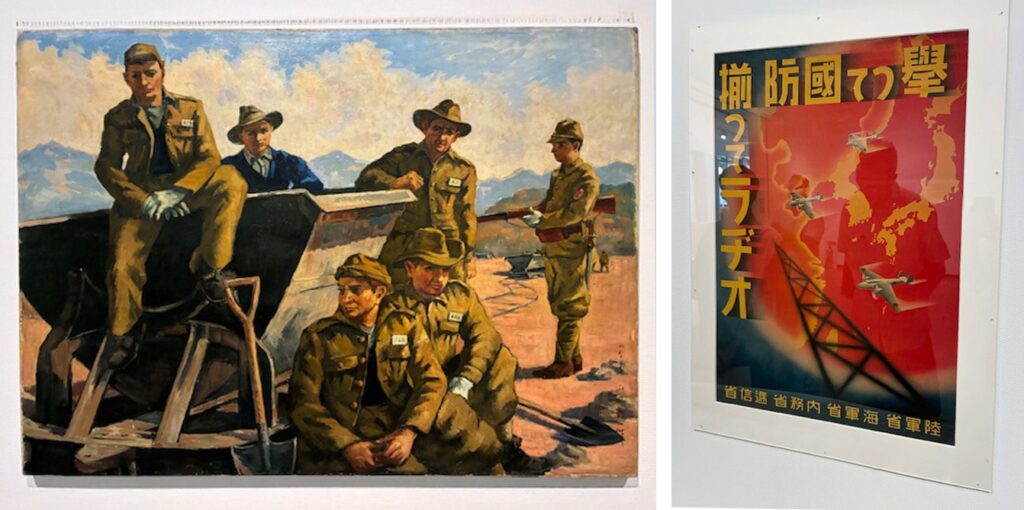Wartime and Propaganda Images Mark End of War Anniversary
To commemorate 80 years since the end of World War II, The National Museum of Modern Art in Tokyo presented an exhibition until October 26 that reflected on the history and culture of the 1930s to the 1970s through the lens of art.
“Opening Documents, Weaving Memories: A Special Exhibition Featuring Works from the Museum Collection” centered on works from the museum’s collection enriched with material from other institutions, a press release said. The exhibition focuses on the documentary role of visual media such as painting, photography and film, while also examining the role of memory in reconstructing the past through a selection of works in these media.

The museum website says “Art is often said to be a ‘mirror of the times.’ Its visual images are imprinted with the social condition and culture at the time of creation through artists’ sensitivities. There is more to it than that. Art lives on through the ages and is therefore given new meanings by later generations. What art reflects are the changes in people’s sense of beauty and the way they look at society and history over the course of time, from the past when the works of art were created to the present.”

“Eighty years after the end of World War II, we face the question of how generations with no direct experience of the war can engage with the past. Ultimately, the answer depends on how we, living in the present, choose to act. This exhibition will feature 280 works including War Record Paintings and materials, mainly from the museum’s collection, as well as loans from other institutions. Documents of the past remain available for us to open and explore, weaving new memories of war. We believe that the museum can serve as a collaborative space where memories are created and shared.”

What Did Paintings Communicate?
From the 1930s onwards, which saw the Manchurian Incident, the Second Sino-Japanese War and the Pacific War, new media such as radio and film rapidly developed and spread in addition to traditional media of newspapers and magazines. This opening section of the exhibition examines painting’s role in this media environment during wartime.
Views of Asia / Views from Asia
As Japan’s sphere of influence expanded, numerous paintings, photographs and films were produced that conveyed the nature, customs and culture of not only Northeast Asia, but also Southeast Asia. By highlighting both what was included and what was omitted from these depictions, this section invites reflection on the back-and-forth gaze between Japan and Asia and the political dynamics at work in this interplay.

The Battlefield as Spectacle
During the Second Sino-Japanese War and the war in the Asia-Pacific, the Army and Navy commissioned mid-career artists to create Operation Record Paintings, which were presented at various war art exhibitions. This section examines why paintings were used—rather than photography or film—to convey the realities of war through the lens of spectacle in battlefield imagery.

Production of Myths
Art during wartime provided images that reflected the times in conjunction with other artistic genres such as literature, music and film. This chapter examines the process of creating “narratives” that deeply penetrated the masses and moved society by focusing on the media space of the time.
War on the Home Front
This section examines how everyday life changed during total war, when the boundaries between the front lines and home front, public and private, male and female and adult and child became blurred, using visual media as a reference. In particular, by focusing on the lives and labor of women who supported the home front, we reexperience the reality of war and daily life going hand in hand.
Memories Imprinted on the Body
In the 1950s, following the harsh experience of defeat, numerous images of wounded, deformed and fragmented bodies, which had not been depicted during the war, were created as a medium for superimposing the postwar reality onto the experience of war. These images of the body evoked memories of the past war.

Dialogues with the Resurrected Past
From the late 1960s to the 1970s, while there were calls for the fading of wartime experiences, images of the Vietnam War shown on television prompted Japanese people to recall past wars. Activities to uncover war memories during this period brought about a shift in public awareness of how to engage with the past.
Opening Documents
War Record Paintings were confiscated by the American military after the war and stored in the US for many years. After negotiations, the works were returned to Japan in 1970 on indefinite loan. This chapter examines the process by which the War Record Paintings were reinterpreted after returning to Japan following the experience of defeat and the postwar blank period, and asks how they can be utilized in the future.

